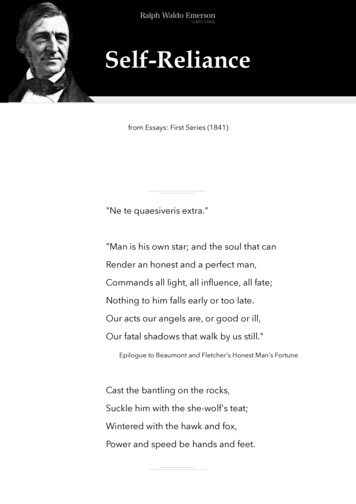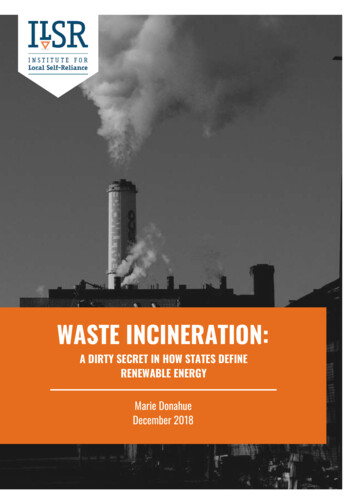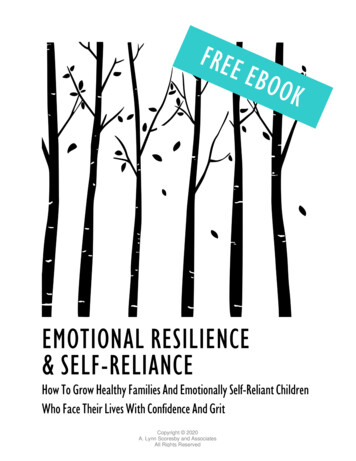
Transcription
Nordic Journal of African Studies 12(2): 196–219 (2003)THE CONCEPT OF SELF-RELIANCE INCOMMUNITY DEVELOPMENT INITIATIVES IN THECAMEROON GRASSFIELDSCHARLES C. FONCHINGONG & LOTSMART N. FONJONGUniversity of Buea, CameroonABSTRACTThe Grassfields of Cameroon is a fertile ground for self-help efforts. This paper examines theresurgence role Village Development Associations (VDAs) are playing in national andcommunity development. Community members are increasingly shouldering the adverseconsequences of the economic downturn and the growing inability of the state to provideeconomic and social development by initiating, mobilising and galvanising their ownresources in the quest for improving their standard of living. The reliance on indigenoustechnology and local human resources has led to overwhelming popular participation incommunity-driven development.Key words: grasslands, self-reliance, community development, local participation, villagedevelopment associationsINTRODUCTIONA notable feature of the crisis racing through Cameroon has been itsoverwhelming impact on the vast rural population, subjecting it tounprecedented economic and social dislocation. Many rural areas are finding itdifficult to cope with the decline. The situation has been worsened by theincreasing inability of the state to respond effectively and adequately to the ruralcrisis. The worsening problem of resource scarcity in sub-Saharan Africandictates that governments can no longer rely on conventional means tosuccessfully address the basic needs of their populations. Communityparticipation has been advanced, and in fact tried, as a strategy that can bepotentially viable in complementing efforts to meet the needs (Njoh 2002).The stagnation and undiminished scale of poverty has given rise to numerousstrategies and initiatives at the grassroots level to help cope with the decline. Itis against this backdrop that some village development associations will beexamined since their contribution towards meeting the basic needs of the localpopulation and the sustainability of local economies is overstated. AsGooneratne and Mbilinyi (1992) put it, confronted with growing poverty andeconomic stagnation or depression in the 1980s and early 1990s, self-reliance
The Concept of Self-Reliancehas been advanced as a viable alternative strategy to “dependent development”and donor-led “structural adjustment” in developing countries.Self-reliance is considered not “merely a necessity but a matter of survival”(Galtung et al., 1980). Indigenous development initiatives have experiencedupsurge in the Grasslands. The size, scope and function of these inward-lookingstrategies of development will be detailed, indicating the essential features fortheir proper functioning. In fact, the population of the Grassfields possesses thecreativity to adapt new techniques and knowledge to their local realities(Acho-chi, 1998). Development literature is replete with cases of communalefforts wherein the economy of affection in which both town dwellers andvillagers are held together in webs of kinship and tribal obligation contributesinordinately to basic survival, social maintenance and development (Hyden,1983).This study thus set out to analyse the evolution and activities of somecommunities in local development endeavours within the Grasslands ofCameroon. In addition, the study also seeks to determine the ability of thesecommunities to provide collective security through self-reliant efforts againstthe backdrop of economic restructuring in the country since the late 1980s.The geographical context of the researchCameroon is located in Central Africa. It has a population of 16.2 million withhigh densities recorded in the cities and the Grassfields area, where most of thepopulation are rural dwellers.The Grassfields region of Cameroon is quite a large area in both size andpopulation. This region falls within the western highland region of Cameroonand is characterised by savannah vegetation. It is designated grasslands becausea greater proportion of the area is covered by grassland than forest. The part ofthe Grassfields in this study is limited to the Bamenda grassfields, whichembodies most of the North West province. The region is characterised bycommon cultural and traditional traits, socialisation processes and other distinctphysical and economic features.Based on trends observed in the literature on community development andthe geographical realities of the Grassfields of Cameroon, data collection andanalysis for this study are based on three guiding hypotheses: Village development associations are playing a greater role in thedevelopment drive of the Western grassfields; The contribution of the elite and women is an important component of selfreliant development in the Grassfields of Cameroon; and The harsh effects of implementation of the Structural Adjustmentprogramme and diminished state intervention have fostered inward-lookingdevelopment strategies.197
Nordic Journal of African Studies1. METHODOLOGY OF THE STUDYThe uniformity of the human and economic landscape of the Grassfields allowsfor random sampling and survey techniques to be applied for data collection.The analysis is therefore based primarily on findings from interviews withmembers of Village Development Associations (VDAs) and traditional councilsconducted in Abebung, Mbemi and Pinyin villages of the Grassfields. This isaugmented with a review of secondary data on self-reliant efforts in somevillages of the region and beyond which are incorporated for a comparativeanalysis.The choice of these villages is guided by information contained in existingliterature. These villages have shown a successful mobilisation of localresources through the creation of local autonomous structures that liase withother village development associations outside the village. The elites’ role is astrong determinant in the success and follow up of projects in these villages. Inaddition to all these factors, these villages are located in administrative divisionsof the area; they share common locally realised projects and the different VDAswere created at different times.A common questionnaire and interview guide on community participation inself-help projects was administered in the chosen villages followed by focusgroup discussions with some members and representatives of local institutionslike schools, health units and women’s groups, that have also contributed tothese local development initiatives in one way or the other. There was a series ofdiscussions with the stakeholders of the different VDAs, governmentcommunity development officers and NGOs operating in the area on thestrategies and management of projects and the level of networking among them.These field visits provided the opportunities to visit and appraise the projects sofar and to observe how debates are conducted in some of the meetings.The data collected have been analysed both qualitatively and quantitativelyand discussed in line with the research hypotheses. Quantitative data have beenpresented in the form of tables and spatial phenomena illustrated by the use ofmaps and comparative discussions using materials from related literature.1.1 THE CONCEPT OF SELF-RELIANCESelf-reliance is one of the bases of effective community development inCameroon as it is in most of Sub-Saharan Africa. In fact, the concept of selfreliance is located centrally within the discourse of community development andis connected to related concepts like self-help, mutual-help, indigenousparticipation and rural development. It advocates the need for people to improvetheir condition using local initiatives and resources in their own hands. Theconcept is fast being accepted as a new formula for community development. Itswidespread acceptance in the development planning of most African countries198
The Concept of Self-Reliancehas the tendency to give greater stimulus and cohesiveness to communitydevelopment in these countries (Anyanwu, 1992).Anyanwu (1992) contends that in most African countries communitydevelopment has depended significantly on voluntary cooperative efforts. Thisfollows a traditional trait that clearly underscores the virtue of self-reliance. Thisexplains the emerging trend in community development, which sees it as animportant point of take-off for better living. The emphasis is to involve groupsof people in planned programmes from which they may gain skills that willenable them to cope more successfully with the problems of their everyday life.Self-reliance is thus “development on the basis of a country’s (region’s) ownresources, involving its populations based on the potentials of its cultural valuesand traditions”(Galtung 1980). Communities and individual people define theirown development according to their own needs, values and aspirations(Preiswerk, 1980).Local-level development provides a major force in activating the utilizationof local resources (land, water, labour) and therefore constitutes one of the mosteffective methods of promoting people’s participation in determining their owndevelopment. The needs for local alternatives and self-reliance have been voicedin more explicit terms by other scholars. For example, Brett (1988) has calledfor cooperative and voluntary alternatives, while Sandbrook (1985) hasemphasised the need for “small-scale community solutions”. In its fundamentalsense, self-reliance is defined as a state of mind that regards one’s own mentaland material resources as the primary stock to draw on in the pursuit of one’sobjectives, and finds emotional fulfilment not only in achieving the objectivesbut of having achieved them primarily by using one’s own resources.In the villages under study, the community has contributed to developing itsinfrastructure and social services. Self-reliance in community developmentdemands that community members apply their knowledge and skills to theresources at their disposal. This ties in with Anyanwu’s observations that thedevelopment of related skills and attitudes of a people can enable them to satisfytheir basic needs, to grow self-reliant, and to minimise precarious dependenceon agencies external to their communities.The concept of self-reliance does not differ significantly from the principlesof self-help and mutual help. The self-help philosophy is closely related to selfreliance as defined by Ghari (1980) that self-reliance through cooperation is nowbeing promoted throughout the developing world for no egalitarian societyshould be chronically unable to meet a self-defined, local need.Self-help enables the local people to exploit to their advantage resources,which would otherwise lie dormant and thereby perpetuate the ignorance andpoverty of their community, by making use of the under-utilised labour; theinstance self-help for community development can increase the competence andconfidence of a community in handling its affairs. The habit of self-help is aprerequisite for survival in the modern world (Anyanwu 1992). Self-helpinitiatives enable the people to look inwards by rallying local resources andefforts. This is especially appropriate to the concept of community development,199
Nordic Journal of African Studieswhich stresses the importance of people increasing their sense of responsibility,and looking assistance as just supplementary, but never replacing popularinitiatives or local efforts. The emphasis is on democratising with reliance onwhat people can do for themselves. The principle of self-help incorporates intothe community development process the means of offering ordinary citizens theopportunity to share in making important decisions about their living conditions(Anyanwu 1992). This approach echoes the people-centeredness of communitydevelopment-attempts at satisfying felt needs. This entails communityparticipation at all levels of the project, a tendency that is noticeable in thecommunities under study.1.2 SELF-RELIANCE IN THE CAMEROON GRASSFIELDSSelf-reliant development is not a new phenomenon in the Grassfields ofCameroon. It is enshrined in the customs and traditions of the people of thisarea. Before European imperialism in Cameroon, genuine communityparticipation could be seen in the construction and maintenance of palaces,village to farm roads, inter village roads, and shrines. The British ColonialAuthority introduced the system of ‘Indirect Rule’, which was intended to be acontinuum of the “old order”. Through this British colonial policy, the positionof the traditional authority was strengthened in the area. The British ruling thepeople through this traditional authority had the capacity to rally the inhabitantsfor local development. But the privileged position enjoyed by traditionalauthorities in the Grassfields area did not obtain in French Cameroon where thepolicy of ‘assimilation’ prevailed. In the former British Cameroon that retainedsignificant political and economic autonomy, the existence of all sorts of localassociations were much more numerous than in the Francophone part of thecountry (Geschiere, 1995). Moreover, the local development approaches in boththe British and French Cameroon were different even in appellation;‘community development’ and ‘action communautaire’ respectively (Yenshu1997) prior to independence in 1960. The traditional hierarchical institutionswith the chiefs at the helm were a heritage of British colonial rule. Geschiere(1995) observed that in the adjacent part of the former French Colony Bamileke part of the Western grassfields - such associations were relativelystrong as well. The chief are still at the centre of an elaborate set of more or lessesoteric associations around their courts. He further notes that in the diaspora,migrants from the same chiefdom created pseudo-traditional associations inorder to foster cooperation in their new surroundings and retain the link withtheir chief.It is no surprise therefore that village community projects (VCPs) realisedthrough popular participation are relatively common, well managed, andsuccessful in this part of Cameroon. Although the post-independence periodwitnessed an increase in local participation, mostly in the execution of200
The Concept of Self-Reliancegovernment initiated and sponsored projects, the 1990s have seen anunprecedented avalanche of self-reliant projects through enthusiastic andcommitted local participation within the Grassfields. This turning point indevelopment and assertiveness of village development associations (VDAs)from the 1980’s is a partial response to the economic crisis that hit the countryduring this time and the stringent adjustment measures that were laterimplemented by the government in 1990 following the prescriptions of theWorld Bank and IMF.While the economic crisis reduced government foreign exchange earningsand thus its ability to accomplish major infrastructural developments in thecountry, adjustment measures also led to direct cuts in state spending on suchvital sectors education, health and rural amenities which needed seriousattention. The situation was clear: the population needed these services andgovernment could no longer provide them.Self-help-driven development has proved its usefulness as an easy, all-onboard and results-oriented approach to contemporary modes of translatingboardroom ideas into meaningful development at least in this focus area. It isvery possible to transcribe their novel approach into a standard method ofintervention in micro financing development projects in remote rural areas. Thevillage development associations in the grassfields have democratic structureswith an executive board that works in collaboration with committees and subcommittees depending on the nature of the project. It is worthy to note thatcongresses and mini-congresses are organised annually for stocktaking ofongoing projects and contributions requested for other projects in the pipeline.During such grand foras, traditional dishes, sketches, dances, exhibitions areorganised as a form of cultural inclusiveness and fund-raising. Contributionscollected from the chapters and branches represented throughout the nationalterritory are presented to the congress by the branch presidents or theirrepresentatives. This is the operational structure with most VDAs in the regionthat have very vibrant branches in major cities of the country. Members arelevied when there is a project at hand and the elite because of their privilegedposition are requested to contribute generously. This may also take the form ofthe organisation of traditional dances in order to raise the much-needed funds.This is the case of the Mankon Cultural and development Association(MACUDA) - Buea chapter that recently organised a fundraising gala geared atthe completion of a library project in the village. Jua (2002) notes that the firstcongress of the NADA in 1984 was attended by hundreds of people living andworking outside of the Njinkom Area. The “white paper creating the associationstated succinctly: “Unless a people takes its development into their own hands,nobody will do it for them” is instructive of the centrality of self-reliance in thedevelopment area of the grasslands. They raised more than US 10.000 withmore than 8,000 of the total coming from people living in urban areas. As seenin the VDAs in the study, the contributions of the branches are very vital to theoverall implementation of identified projects.201
Nordic Journal of African StudiesCommunity participation in liaison with NGOs is an added dimension ofcommunity development in the grassfields. An International NGO like the SwissAssociation for Int. Development (HELVETAS) is heralded as a partner in selfreliant development in the Cameroon grassfields. Their intervention in pipeborne water schemes, road rehabilitation and development of water catchmentsin collaboration with the communities is remarkable. They work with villagedevelopment associations and other grassroots structures in the maintenance ofpipelines, digging of trenches, supplying sand, stones and laying of pipes fordistribution of water to quarters in the various localities. The water managementcommittees that are an auxiliary of the Village Development Associations arevery instrumental in handling problems that relate to distribution andmaintenance of water points. In the case of Lower Mbot (Donga-MantungDivision) women were levied 500frs and men 1000frs for the maintenance of itswater system. In Mbinkar (a nearby locality), the Village DevelopmentAssociation is very supportive in road rehabilitation through cleaning ofculverts, chopping of grass around major roads and the filling of potholes.Membership contributions constitute an important source of start-off capital forexecution of projects. The case of Ndu, a locality in the Northwestern grassfieldsis glaring where the identified catchment area had to be protected fromencroachment through the planting of particular tree species (pear, orange,African panaxia). In order to develop the pumping station, women were levied2000frs and men 4000frs. The modus operandi is slightly different with theNADA where statutorily, membership contributions were fixed at 6000 francsCFA for people living in urban areas, 500frs and 250frs for the village male andfemale adult respectively. Members are however, encouraged to contribute asmuch as they can (Jua, 2002).The elites constitute a strong force in community development endeavours inthe grassfields as elsewhere in Cameroon. Since the game of politics isdetermined by the lobbying capacity of the region, its elite plays a central role incanvassing for resources from the central government. They also use existingvillage/community associations and committees as a political base and back upfor their actions. Their support to community development initiatives ispremised on the readiness of the community members to reciprocate when suchillustrious sons or daughters’ need to garner political support especially duringelections. Jua (2002) states that the over-riding reason to create NADA (1984)was spearheaded by some of its elites who wanted to reverse the trend of theeconomic meltdown and to promote the prominence of Njinikom as a collective.As seen in the showcases in this study, the elites occupy a prominent position asfar as turning the table in community development activities. Their contributionsare usually very high and their share is equally very determinant in the executionof projects. During contributions, elites see this as a means to social promotionand prestige and therefore contribute generously (Nkwi, 1997). The village ofNkouondja in the Western grassfields is a case in point. The villageDevelopment Committee made up the shortage in contribution towards theirwater supply project by sending an emissary to a neighbouring country (Gabon)202
The Concept of Self-Reliancewith a strong representation of the elites who were working there. The emissaryreturned with 500,000frs CFA, more than the amount expected (IRC, 2002).However, their participation is against the backdrop of the prevailing philosophyin official circles where it is common place to argue ‘politics na njangui’(politics is a game of give and take or a quid pro quo, Jua 2002), the elite havesabotaged or stifled associations especially if they do not share similar politicalstripes. The polarization and return favours expected by elites has createdunnecessary tension leading to the dysfunction of some Village DevelopmentAssociations. As funds become unavailable or dry up, dissenting voices creep inand these financial constraints has forced some Village DevelopmentAssociations to scale back on identified projects. This also has dampeningeffects on the enthusiasm of community members. Jua (2002) explains theimplosion of NADA with the decentring of the development goals of theAssociation and its politicization became a new ground for political struggleamong the elites and political parties.2. THE PLACE OF COMMUNITY PARTICIPATION IN LOCALDEVELOPMENTCommunity participation is the secret of the success of self-help projects in theGrassfields. Participation is both in kind and in cash. There is usuallyenthusiasm from the community to participate in projects since the adoption ofprojects is arrived at through consensus and these projects must meet theaspirations of all classes of the society. The example of the Abebung HealthProject, which cost about 12 million francs, C.F.A reveals that communityfinancial contributions are determined by the ability of the individual tocontribute. The level of contribution is a factor of where an individual lives,his/her social and economic status. A planning or ad hoc committee usually setsthis amount, which is representative of all the socio-economic and politicalstrata of the village. This representation ensures that group interest is respectedbefore the issue is brought before the general assembly or congress for approval.In other places, just as Anyanwu (1992) noted with the Alara’s palace project, afundraising committee is set up which proposes the levy for each individual.Participation in community development is the cornerstone of thedevelopment process. Concerns for reduction of inequalities and for alleviationof poverty drew attention to the rural areas where the majority of the world’spoor reside. Among the various objectives and strategies of development Bazlul(1994) cites people’s participation at the grass-root level as being pivotal inreducing both poverty and inequality. As a corollary to Bazlul (ibid), Wignaraja(1984) considers people’s participation to be critical in achieving the objectivesof development as he believes that it is a pretence to think that the crises in thedeveloping countries can be overcome or that the reshaping of societies and thedevelopment of its rural areas can be undertaken without the participation of the203
Nordic Journal of African Studiespeople, particularly the large numbers who are poor. Goulet (1989) arguesamong other things that participation by intended beneficiaries is anindispensable feature of all forms of developmentWignaraja (1984) emphasizes the extent of people’s participation byobserving that the rural poor need to become increasingly aware of the socioeconomic reality around them, of the forces that keep them in poverty, and ofthe possibility of bringing about change in their conditions through their owncollective actions. This constitutes a process of self-transformation throughwhich they grow and mature as human beings. In this sense participation is alsoa basic human need. This is manifested in the voluntary contributions either incash or in kind from community members.The UN Food and Agricultural Organisation (1979) also emphasize thatparticipation by the people in the institutions and systems which govern theirlives is a basic human right and also essential for realignment of political powerin favour of disadvantaged groups and for social and economic development.Due to disillusionment with previous development strategies, participation bycommunities has become critical to the development of the countryside throughpopular support and local action. Cohen and Uphoff (1980) maintain that themain thrust behind the concern for participation grew out of disillusionmentwith previous approaches to development, buttressed by diffuseliberal/democratic sentiments.This disillusionment explains why the World Bank on its part holds thatcommunity participation can be a means for ensuring that development projectsin developing countries reach the poorest in the most efficient and cost-effectiveway. Participation consequently expects even the poorest to share in the cost aswell as the benefits of community development. That is why in the villagesunder study, the elements of local action are related to local participation effortsby community members aimed at building the community and improving thewelfare and standard of living of the people. Bazlul’s (1994) conceptualisationof participation is also relevant. He looks at the term ‘participation’ as theinvolvement by more than a few individuals who are involved in a situation oraction to improve their welfare or to achieve some other desired goals. It is aprocess, which involves people at the grass-roots level in collective actions,taking initiatives in spontaneous, creative activities. Rahman (1981) emphasizesthe importance of participation: “ this is what makes the process of people’s ownas opposed to the people being mobilized, led or directed, by outside forces. ”Participation and community development have been identified as keyconcepts in development with the emphasis on “the direct involvement ofordinary people in local affairs (Midgley et al 1986).” The stream ofdevelopment thinking points to participation as a process of empowering thosewho were previously excluded from achieving power; that is, “power in terms ofaccess to, and control of the resources necessary to protect livelihood (Oakleyand Marsden 1984).” These concepts are in tandem with the efforts ofcommunities to initiate and realise that their projects (Table 1) based onavailable resources.204
The Concept of Self-RelianceThis means that a community can include a group of people spread overdifferent places, who can still be closely in touch and able to plan and act inconcert (Anyanwu 1992). In this way, the community remains an area of socialcoherence and is based on locality and community sentiment.Scholars and policy makers have expressed diverse views on the concept ofcommunity development. Gary Craig’s (1998) view is tied to the notion ofpromoting community participation as a means of enhancing the developmentprocess. He cites the Brundland Commission (WCED, 1997), which enlistseffective citizen participation as one of the preconditions to sustainabledevelopment. The Human Development Report (UNDP, 1993) echoes theimperative of people participating in their own development, remarking thatpeople’s participation is becoming the central issue in the face of currentchallenges for development. The Mutengene Water Supply Project is a notableexperiment of community participation and the experience of self-help in waterservice delivery to impoverished populations in Cameroon. The various phasesof the project when it was initially hatched in 1959 to date shows the dire needof the inhabitants to continuously furnish the town with potable water supplyamidst hurdles. The ad hoc committee set up for the realisation of the projectconducted feasibility, studies leading to the identification of a natural spring.Local residents had to contribute to defray the cost of engineering,technical/managerial services and construction materials (see Njoh, 2002). Theywere assisted by financial grants from governmental and some nongovernmental organisations. The levying Scheme for the Mutengene WaterProject of the Southwest province of Cameroon is slightly different from whatobtains in the grasslands. Residents were grouped into two classes. For schemeone, businessmen were levied 500frs, Formal sector workers; 500frs, Informalsector men; 400frs and informal sector women; 200frs. For scheme two,businessmen were levied 1000frs, Formal sector men; 1000frs, Businesswomen;800frs, formal sector women, 800frs; Informal sector men, 600frs and Informalsector women; 400frs (Njoh 2002).2.1 VDAS AS DEVELOPMENT AGENTS IN THE GRASSFIELDSThe Pinyin Development Organisation (PDO), the Abebung Development andCultural Association (ADCA) and the Njindom Cultural and DevelopmentAssociation (NJICUDA) were founded in 1974, 1978 and 1994 respectively.The goal of these VDAs is to bring development to their respective areasthrough self-reliance, to act as pressure groups vis-à-vis the state and to preservetheir cultural values, identity, and unity. These institutions have undertakenconcerted efforts to satisfy the pressing needs of their communities. Priorityprojects nonetheless diffe
Nordic Journal of African Studies 12(2): 196–219 (2003) THE CONCEPT OF SELF-RELIANCE IN COMMUNITY DEVELOPMENT INITIATIVES IN THE CAMEROON GRASSFIELDS CHARLES C. FONCHINGONG & LOTSMART N. FONJONG University of Buea, Cameroon ABSTRACT The Grassfields of Cameroon is a fertile ground for self-help efforts.File Size: 902KBPage Count: 24










